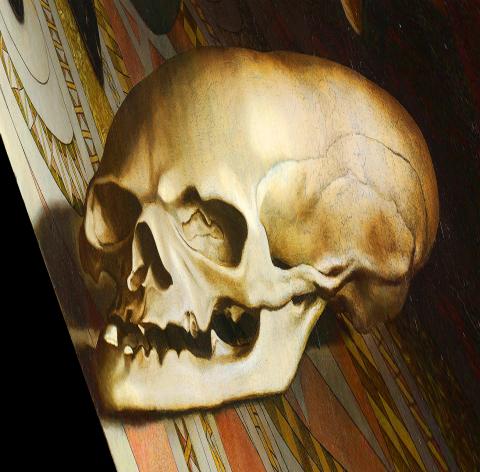The painting The Ambassadors is the work of Hans Holbein the Younger (c. 1497-1543). Holbein was a leading figure in the Northern Renaissance style (which differed from the Renaissance style prevalent in Italy and Spain), and specialized in religious painting before Catholic religious imagery was prohibited in the Germanosphere during the Reformation. Holbein then moved to England, where he became a painter for the Tudor court, turning his hand instead to portraits of royalty and the aristocracy in the employ of King Henry VIII.
This life-size painting depicts two men leaning with their arms resting on a two-tier rack of shelves. On the left is the French ambassador to England Jean de Dinteville; on the right is French diplomat and ecclesiastic Georges de Selve. In the lower half of the painting lies a mysterious object with the appearance of a diagonally-oriented shadow, an example of the famous anamorphosis. If one looks at the painting from the lower left one can discern the shape of a skull (see photo of detail). It is believed that the painting was originally hung to the side of a staircase, and so when one approaches it from either side, walking up or down the stairs, the anamorphic skull appears as if floating above the surface of the painting.
Even though Holbein had moved from religious to secular painting, in this work he still employs the symbolic meaning of religious iconography. On the upper shelf there are objects including a celestial globe, a sundial and a quadrant, while on the lower shelf lie a terrestrial globe, a mathematical book with a ruler between its pages and a lute, its neck framing an open Lutheran Psalmbook. These objects symbolize various fields of learning: astronomy, mathematics, geometry and music. If one looks closer, one can see the lute has a broken string: some scholars believe this represents discord between science and the Church.

Photo: Wikimedia Commons
照片:維基共享資源
Holbein’s approach here is an example of the vanitas paintings popular in the day, symbolic works expressing the certainty of death and the illusory nature of earthly pleasures. It is recorded that de Dinteville’s motto was the Latin phrase memento mori (Remember thou shalt die). The liberal use of symbols of knowledge and the attention to detail in the clothing, fur and textiles in this painting also point to the concept that all material things are but illusory and non-substantial, while true substance lies in the non-material.
(Translated by Paul Cooper)
《大使》為小漢斯‧霍爾班(約西元一四九七~一五四三年)所作。霍爾班是「北方文藝復興」(有別於義大利、西班牙的文藝復興風格)的代表之一,原擅長宗教畫,後因日耳曼地區的宗教改革禁止崇拜天主教形象,而移居英格蘭成為宮廷畫家,為亨利八世等都鐸王朝貴族繪製肖像。

Photo: Wikimedia Commons
照片:維基共享資源
在這真人大小的巨幅畫中,左方的法國駐英格蘭大使尚‧德‧丹特維爾,及右方法國外交官兼教士喬治‧德‧賽弗,各以一手倚在一個雙層架上。畫面下方,卻有個斜置的像是一道陰影的謎樣東西。此為「變體畫」的著名例子──若我們由左下往上看即可明白──這是個骷髏頭。據說此畫原掛在樓梯旁,隨著上下樓移動視點,這骷髏頭便彷彿來自異空間地浮現出來。
霍爾班的作品由宗教轉為世俗,但此畫中俯拾皆是有如宗教圖像學的象徵意義。架子上層擺了天球儀、日晷、四分儀等,下層則是地球儀、夾著直角矩的數學書籍、魯特琴,以及右前方路德教派讚美詩歌本。這些物品象徵了天文、數學、幾何、音樂等學問。然而若細看,魯特琴卻有一根弦因斷裂而翹起──有學者認為這象徵著科學與宗教的不和諧。
這樣的手法類似當時流行的「虛空派」靜物畫──其旨在表達只有死亡是唯一的必然,一切浮華的人生享樂都是虛無的。據載,丹特維爾的座右銘為拉丁文「memento mori」(人終須一死),由是,此畫機巧的智識、精緻如真的衣飾、皮草、織品,便是「色即是空,空即是色」了。
(台北時報林俐凱)

When Nvidia CEO Jensen Huang revealed on Friday last week that the company is working with the Trump administration on a new computer chip designed for sale to China, it marked the latest chapter in a long-running debate over how the US should compete with China’s technological ambitions. The reasoning has sometimes changed — with US officials citing national security, human rights or purely economic competition — but the tool has been the same: export controls, or the threat of them. Nvidia believes it can eventually reap US$50 billion from artificial intelligence (AI) chip sales in China. But it so far has

Long before numerals and arithmetic systems developed, humans relied on tally marks to count. These simple, repeated marks — often just straight lines — are one of the earliest and most widespread methods of recording numbers. Archaeological findings suggest that humans began tallying in prehistoric times. During the Late Stone Age in Africa, humans began to carve notches onto bones to create tangible records of quantities. One of the earliest known examples is the Wolf bone, an artifact unearthed in Central Europe in 1937. This bone bears notches believed to be an early form of counting. Even more intriguing

A: In addition to Teng Kai-wei, Taiwanese infielder Cheng Tsung-che was called up temporarily to play for the Pittsburgh Pirates in early April. B: Yeah, Cheng is the 18th player in Taiwan’s baseball history to be moved up to the majors. A: Back in 2002, Chen Chin-feng became the first Taiwanese to play in the Major League Baseball (MLB), followed by Tsao Chin-hui, Wang Chien-ming, Kuo Hung-chih, Hu Chin-lung and Lin Che-hsuan. B: Those pioneers were later joined by Lo Chia-jen, C.C. Lee, Ni Fu-te, Chen Wei-yin, Wang Wei-chung, Hu Chih-wei, Tseng Jen-ho, Lin Tzu-wei, Huang Wei-chieh, Yu Chang,

Continued from yesterday(延續自昨日) https://www.taipeitimes.com/News/lang In many Western countries, the most common form of tally marks employs a five-bar gate structure: four vertical lines followed by a diagonal slash. To form this group, one begins by drawing four parallel vertical lines, each representing one. For the fifth, draw a diagonal line across the existing four. This diagonal stroke effectively creates a distinct group of five. To continue counting, just initiate a new cycle in the same manner. A set of five tallies combined with a single vertical line next to it represents the number six. Across many Asian countries, the Chinese character